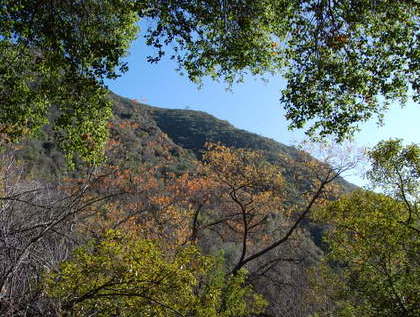Orange County Day Trip: Holy Jim Canyon
Once upon a time, Orange County was wild. Mule deer, bears, and mountain lions far outnumbered homesteaders, and the real housewives were much more focused on growing dinner than throwing a dinner party.
Today, suburban sprawl dominates much of what was once wild, and the chaparral that once covered most hillsides has been replaced by asphalt and stucco. At first glance, folks wouldn't think there was anything wild left in Orange County. Those folks have never been to Holy Jim Canyon.
 Five-and-a-half miles up a dirt road due east of Trabuco Canyon, Holy Jim Canyon is as far away from the McMansions as you can get. The 40 or so bungalow-style cabins that call this forested spot at the base of Santiago Peak, also known as Saddleback Mountain, home aren't reached by power, water, or sewer lines. Residents, all part-timers per the conditional lease with the National Forest Service, couldn't be happier about their life off the grid. They consider the fire danger, washed-out road, and flood potential -- a major flood caused extensive damage in December of 2010. It's a small price to pay for their own little slice of heaven amongst big-cone spruce and spring-fed streams.
Five-and-a-half miles up a dirt road due east of Trabuco Canyon, Holy Jim Canyon is as far away from the McMansions as you can get. The 40 or so bungalow-style cabins that call this forested spot at the base of Santiago Peak, also known as Saddleback Mountain, home aren't reached by power, water, or sewer lines. Residents, all part-timers per the conditional lease with the National Forest Service, couldn't be happier about their life off the grid. They consider the fire danger, washed-out road, and flood potential -- a major flood caused extensive damage in December of 2010. It's a small price to pay for their own little slice of heaven amongst big-cone spruce and spring-fed streams.
While most of these residences were built by transplanted Iowans looking for a weekend escape from the urban life in Long Beach back in the 1920's, the canyon had been inhabited for at least 40 years prior to their arrival. In the 1880's, a beekeeper by the name of James T. Smith set up shop in the canyon. Jim was known for his colorful vocabulary and folks gave him the nickname "Cussin' Jim." Friends, trying to get his goat, jokingly started calling him "Salvation Smith" and mapmakers, perhaps in on the joke as well, named the canyon "Holy Jim" in his honor.
 During the 1970's the canyon and nearby Forest Service campgrounds were invaded by hordes of hippies. The flower children were no longer welcome when they started vandalizing property, so cabin owners flushed them out by flooding their camp with water from the Holy Jim volunteer fire truck. The Forest Service closed the campgrounds and peace was restored to the canyon.
During the 1970's the canyon and nearby Forest Service campgrounds were invaded by hordes of hippies. The flower children were no longer welcome when they started vandalizing property, so cabin owners flushed them out by flooding their camp with water from the Holy Jim volunteer fire truck. The Forest Service closed the campgrounds and peace was restored to the canyon.
Hippies weren't the only troublemakers to occupy Holy Jim Canyon. A grizzly bear turned honey thief began habitually raiding beekeepers' apiaries in 1908. Beekeepers aren't particularly fond of honey thieves, so the men men grabbed their guns, hopped on their horses, and didn't rest until that bear was dead. That bear was the last known grizzly to ever roam Orange County.
 These days, bear tracks have been replaced by the imprints of hiking shoes as Southern Californians escape the noise of urban life and walk Holy Jim Canyon's quiet trails. The most popular route is an easy 2.7-mile out-and-back trip to a 20-foot waterfall deep in the canyon. The journey includes multiple stream crossings (which can involve a bit more scrambling during the rainy season), a gentle 600-foot elevation gain, and plenty of opportunities to fall in love with the wilds of Orange County.
These days, bear tracks have been replaced by the imprints of hiking shoes as Southern Californians escape the noise of urban life and walk Holy Jim Canyon's quiet trails. The most popular route is an easy 2.7-mile out-and-back trip to a 20-foot waterfall deep in the canyon. The journey includes multiple stream crossings (which can involve a bit more scrambling during the rainy season), a gentle 600-foot elevation gain, and plenty of opportunities to fall in love with the wilds of Orange County.
To get there: Take I-5 to Lake Forest, exiting on El Toro Road. Head northeast for 6 miles and at Cook's Corner, make a right on Trabuco Canyon Road. Follow the oak shaded road for four miles. Shortly past O'Neill Park, right after Rose Canyon Road, take a left on Trabuco Creek Road, an unmarked dirt road. Drive for five and a half miles on the dirt road and arrive at the Holy Jim parking lot just past the volunteer fire station. The road can become washed out just after heavy rains and four-wheel drive vehicles are recommended. A National Forest Service adventure pass (which can be purchased at a local sporting goods store for $5) is required. Leashed dogs are welcome on the trail.
Sharlene Earnshaw is the editor for Trekaroo, a website dedicated to helping families travel better.



